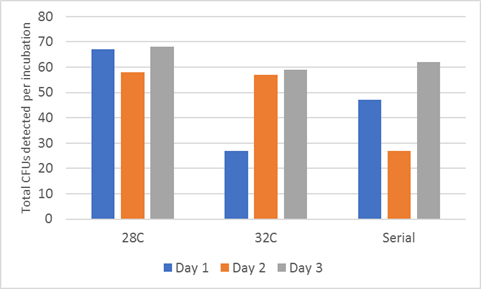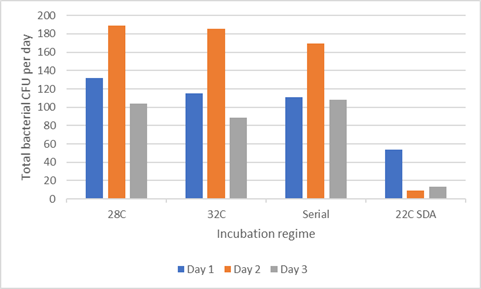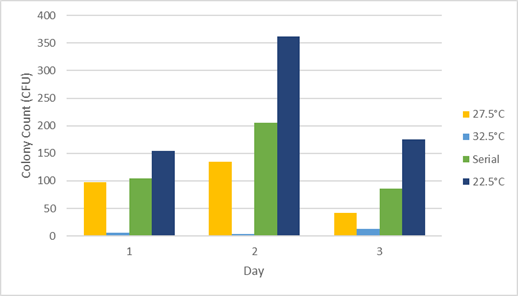

 海博微信公众号
海博微信公众号
 海博天猫旗舰店
海博天猫旗舰店


 海博微信公众号
海博微信公众号
 海博天猫旗舰店
海博天猫旗舰店




Effect of Incubation Strategy on Recovery of Bacteria and Molds in EM Testing
EM(环境监测)检测中培养策略对细菌和霉菌回收的影响
One of the most asked questions in microbial EM testing relates to incubation strategy and media choice.
微生物EM(环境监测)检测中最常遇到的问题之一与培养策略和培养基的选择有关。
Whether to go single temperature or serial and if serial to go low to high or vice versa with use of one media, TSA, or two, TSA and SDA. Factors that can influence the choice are time to results (single temperature is usually faster than serial), cost (TSA alone is cheaper than TSA and SDA) and quality of microorganism recovery. There are few studies reporting recovery related to incubation choice however in those published a single 30-35°C incubation has been reported to give poorer mold recovery than serial. The data below summarizes a small study performed in our facility.
使用一种培养基(TSA)或者两种培养基(TSA和SDA),使用单个温度、两个温度,是否从低温到高温,还是高温到低温。影响微生物回收率的因素有:结果观察时间(单一温度通常比两个温度早)、成本(只用TSA比使用TSA+SDA便宜)以及微生物回收率的高低。很少有研究报告回收率相关的培养条件选择,但是,已有报告单一温度条件30-35℃培养对于霉菌回收的不如两个温度培养的好。下面的数据总结了在我们实验室进行的一项小研究。
Three strategies were evaluated using standard TSA LP80 media, single temperature at 30-35°C, and 25-30°C for 5 days and a serial protocol with 72 hours at 20-25°C followed by 48 hours at 30-35°C. A smaller evaluation was performed to review the recovery of molds with SDA media at 20-25°C for 5 days as the control.
采用标准TSA LP80培养基、分别使用30-35℃@5天、25-30℃@5天、20-25℃@72小时+30-35℃@48小时3种方案进行评价。以SDA培养基20-25℃@5天条件为对照,对霉菌的回收情况进行评价。
The samples were taken from close to the manufacturing floor entrances, from un-controlled areas to ensure high enough cell counts to get suitable data sizes. At each site 3 surface contact plates and 1 active air sample (1m3 SAS 180) were taken making 12 points for each day. At each point 3 replicate samples were taken, 1 cassette for each incubation temperature tested. For experiment 2 an SDA sample was also taken at the same time. Samples were taken in Dec-Jan and then 9 months later in Aug-Sept to cover seasonal variation. All samples were incubated on the Growth Direct™. Following incubation, the data series for each cassette was recovered to determine the cfu counts. For experiment 2, three analysts also counted the number of mold colonies present on each cassette and the mean value was calculated for each sample.
这些样本是从生产车间入口附近的非受控区域采集的,以确保足够高的计数以获得合适的数据大小。在每个地点取3个表面接触皿和1个浮游菌(1立方SAS180),每天取12个点。每个点取3组重复样本,每个培养温度测试1组样品。实验2中还收集了SDA样本。样本分别在12月至1月,以及9个月后的8月至9月采集,以覆盖季节变化。培养后对每组样品进行计数,以确定菌落计数。在实验2中,三位分析员还计算了每个组的霉菌菌落数,并计算了每个样本的平均值。
Figure 1. Total number of Bacterial colonies detected at each incubation strategy over the 3 days of study 1 in Dec-Jan
图1。在试验1的3天内,在每种培养策略下检测到的细菌菌落总数

Figure 2. Total number of Bacterial colonies detected at each incubation strategy over the 3 days of study 2 in Aug-Sept
图2。在试验2的8月至9月的3天内,在每种培养策略下检测到的细菌菌落总数

Overall the single temperature at 25-30°C appeared to have the least variation by day and may have recovered more colonies than the other 2 methods. There is a fairly high variation in this type of testing, so a larger panel would need to be studied to get a firmer data set.
总的来说,25-30℃的单一温度日变化最小,可能比其他2种方法回收了更多的菌落。这种类型的测试存在相当大的差异,因此需要研究更大的面以获得更可靠的数据集。
Mold detection
霉菌检测
The frequency of mold colonies occurring at each test point was recorded over the course of the study. Results are shown in Figure 3. As can be seen The SDA recovered the most colonies as expected. Serial incubation recovered the next highest number then single temperature at 25-30°C and finally 30-35°C. The recovery at 30-35°C was less than 1% of that on SDA.
在整个试验过程中,每个试验点霉菌菌落的发生频率都被记录下来。结果如图3所示。正如我们所看到的那样,SDA(22.5℃)回收了大部分的菌落,组合温度(25-30℃+30-35℃)次之,然后是25-30℃,最后是30-35℃。在30-35℃条件下,回收率小于SDA(22.5℃)的1%。
Figure 3. Total number of mold colonies detected at each incubation strategy over the 3 days of study
图3.在3天的试验中,每种培养策略检测到的霉菌菌落总数

Conclusion
总结
If cost is the driving factor then single media, TSA, with a serial incubation (low to high) is the best option. If speed is the main requirement then the single temperature at 25-30°C is best. If overall recovery is the requirement then 2 media, TSA and SDA is superior.
如果成本是驱动因素,那么单一培养基,组合温度培养(从低到高)的TSA是最佳选择。如果速度是主要的要求,那么25-30℃的单一温度是最好的。如果需要全部回收,那么优选2种培养基,TSA和SDA。
| 相关文章: | ||



